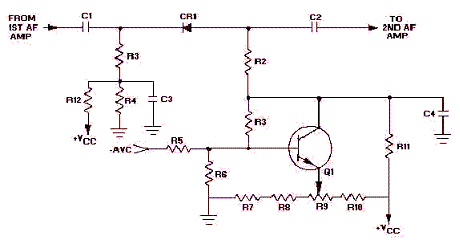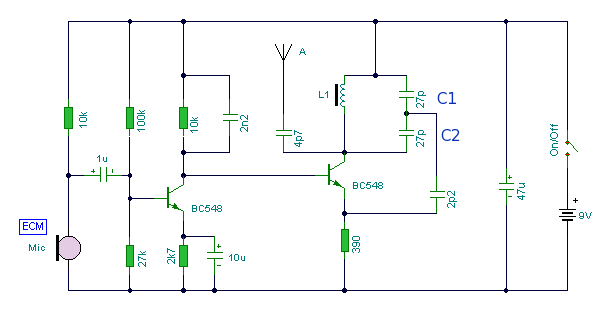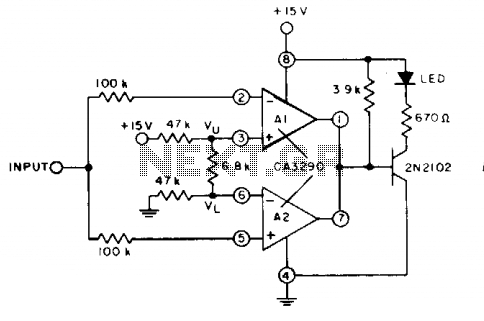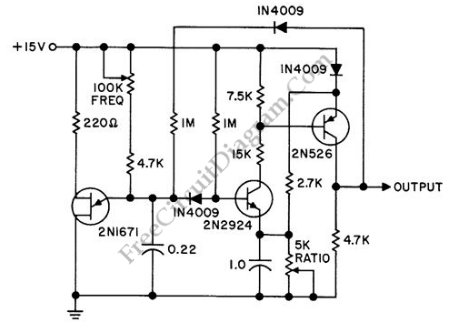
Frequency comparator II
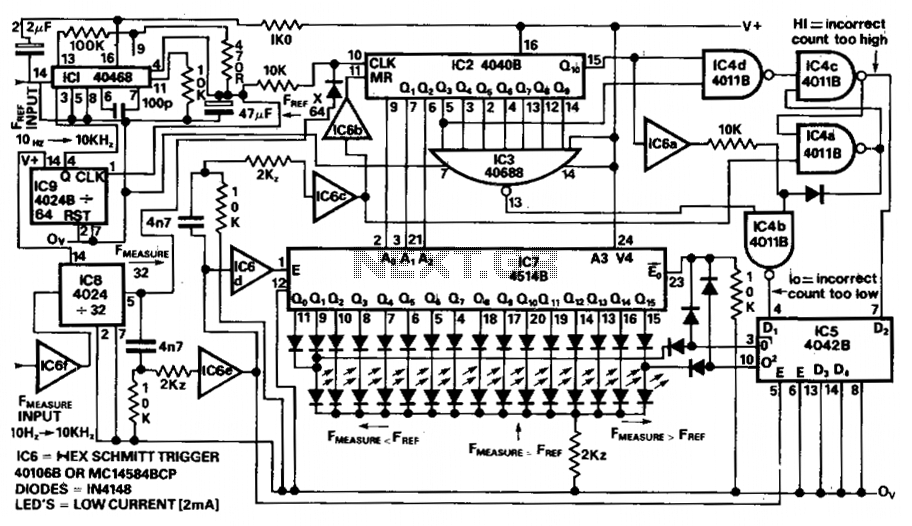
The circuit provides a clear LED display indicating positive or negative values in increments of 0.1%. A reference frequency is generated by multiplying the input frequency using PLLIC1 and divider IC9, resulting in an output frequency of 64 times the reference frequency. This output is then processed by IC8, which divides the measured frequency by 32, establishing a relationship where the reference frequency equals the measured frequency. The counter IC2 counts up to 1024 pulses. If the count exceeds 1031, the latch IC4c/IC4a is activated to signal that the count is too high (measured frequency exceeds reference frequency). Conversely, if the count drops below 1017, IC3/IC4b indicates that the count is too low (measured frequency is less than reference frequency).
These signals are latched by IC5 at the end of each period, triggered by a latch signal from IC6e. When the two frequencies are within a tolerance of ±0.6%, the least significant bits (LSBs) of the counter IC2 are decoded and latched by IC7, which then displays the values on the LEDs. IC6c resets the counter following the data latching process.
The circuit operates by first establishing a reference frequency through a phase-locked loop (PLL) and a frequency divider. This reference frequency is crucial for accurate measurement and comparison against the incoming signal. The division of the measured frequency allows for a manageable range of values for the counter IC2, which is designed to handle up to 1024 pulses.
The use of latches (IC4a, IC4b, and IC5) ensures that the system can reliably capture and hold the state of the frequency measurements at specific intervals, allowing for a stable output on the LED display. The tolerance of ±0.6% is a critical design feature, ensuring that minor fluctuations in frequency do not result in erroneous readings. The decoding and display of the LSBs further enhance the usability of the circuit by providing a precise visual representation of the measured frequencies.
The reset function provided by IC6c is essential for preparing the counter for subsequent measurements, ensuring that each measurement cycle starts from a known state. Overall, the circuit is designed for precise frequency measurement and display, making it suitable for applications requiring accurate and real-time frequency analysis.The circuit provides unambiguous LED + or - bar readout with steps of 0.1%. The reference frequency is multiplied by the PLLIC1 and divider IC9 to output 64 ? F (ref) and this is then gated by dividing F (measure) by 32 in IC8 thus is F (ref) = (measure) then IC2 counts 1024 pulses. Should the count be more than 1031 than the latch IC4c/IC4a is set to indicate count too high (F (measure) F (ref)) and if the count is less than 1017 then IC3/IC4b indicate count too low (F (measure) F (ref).
These signals are latched by IC5 at the end of each period by the latch signal from IC6e. When the two frequencies are within + or - 0.6% the LSB's of the counter IC2 are decoded and latched by IC7 and displayed on LED's IC6c resets the counter after latching the data.
These signals are latched by IC5 at the end of each period, triggered by a latch signal from IC6e. When the two frequencies are within a tolerance of ±0.6%, the least significant bits (LSBs) of the counter IC2 are decoded and latched by IC7, which then displays the values on the LEDs. IC6c resets the counter following the data latching process.
The circuit operates by first establishing a reference frequency through a phase-locked loop (PLL) and a frequency divider. This reference frequency is crucial for accurate measurement and comparison against the incoming signal. The division of the measured frequency allows for a manageable range of values for the counter IC2, which is designed to handle up to 1024 pulses.
The use of latches (IC4a, IC4b, and IC5) ensures that the system can reliably capture and hold the state of the frequency measurements at specific intervals, allowing for a stable output on the LED display. The tolerance of ±0.6% is a critical design feature, ensuring that minor fluctuations in frequency do not result in erroneous readings. The decoding and display of the LSBs further enhance the usability of the circuit by providing a precise visual representation of the measured frequencies.
The reset function provided by IC6c is essential for preparing the counter for subsequent measurements, ensuring that each measurement cycle starts from a known state. Overall, the circuit is designed for precise frequency measurement and display, making it suitable for applications requiring accurate and real-time frequency analysis.The circuit provides unambiguous LED + or - bar readout with steps of 0.1%. The reference frequency is multiplied by the PLLIC1 and divider IC9 to output 64 ? F (ref) and this is then gated by dividing F (measure) by 32 in IC8 thus is F (ref) = (measure) then IC2 counts 1024 pulses. Should the count be more than 1031 than the latch IC4c/IC4a is set to indicate count too high (F (measure) F (ref)) and if the count is less than 1017 then IC3/IC4b indicate count too low (F (measure) F (ref).
These signals are latched by IC5 at the end of each period by the latch signal from IC6e. When the two frequencies are within + or - 0.6% the LSB's of the counter IC2 are decoded and latched by IC7 and displayed on LED's IC6c resets the counter after latching the data.
%2Busing%2Bop%2Bamp%2B741%2Bic%2B.png)

